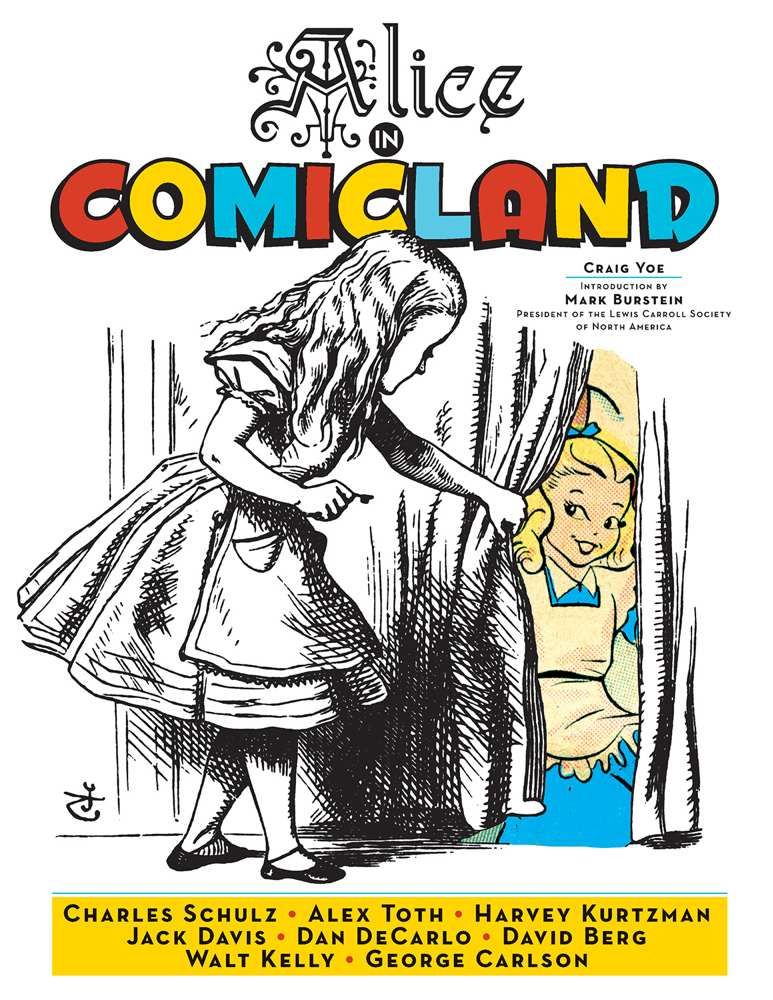Editor, comics collector and designer Craig Yoe has an ideal subject for his latest coffee table-ready anthology: Lewis Carroll's Alice and the myriad ways in which she has appeared in comics, almost since the medium existed. What makes the subject so perfect for such a book is that it's so broad that it's impossible to even attempt to be comprehensive, or even all that representative.
As Mark Burstein, the president of the Lewis Carroll Society of North America, notes in his introduction to Alice in Comicland, appearances by characters from Carroll's Alice books, references and allusions to the works, and the instances of direct and palpable influence by them in comics are simply innumerable. In 2003, he and some colleagues put together a book titled Pictures and Conversations: Lewis Carroll in the Comics: An Annotated International Bibliography, and they tracked some 500 comic books in which Alice characters appear. That was a decade ago.
Now, Alice in Comicland is only about 170 pages long. You could fill a collection five times as big with Batman comics in which he fights villains derived from the Alice books. You could fill books bigger still collecting all of the horror or action or sexually exploitative material derived from Carroll's Alice stories. The almost-astronomical breadth of the subject matter thus gives Yoe and company a pretty valuable pass from any critics. Why isn't this here, or why is that there instead of that other thing? Such second-guessing is natural to a reader, and I found myself wondering why there's a Superman comic rather than a Batman comic, for example, or why there's no mention of, say, Tommy Kovacs and Sonny Liew's Wonderland or Roger Langridge's Snarked or any weird Zenescope books or manga or that Hatter M comic or whatever. But the answer's obvious, isn't it? It can even come in the form of a (bander)snatch of dialogue from Alice's Adventures in Wonderland: No room! No room!
So what we have is another typically beautifully designed book from the Yoe library, this one featuring a John Tenniel drawing of Alice pulling aside a curtain to reveal a die-cut space, behind which we see a full-color, cartoon version of Alice; running along the bottom is a who's who of all-time-great cartoonists: Charles Schulz! Alex Toth! Walt Kelly! Harvey Kurtzman!
Inside is a heavily illustrated introduction by Burstein, in which he talks about the history of the overlap between the Alice books and comics, which were appearing in newspapers during Carroll's lifetime (Tenniel even drew an 1855 proto-comic of sorts, which is reprinted within). That's followed by a piece by Yoe, in which he walks readers through what will follow, and there's a reprinting of a 1916 essay by K.L. Roberts from which the collection gets its name.
There are plenty of very short pieces, including the Schulz contributions (several instances of Snoopy trying to do his "Cheshire Beagle" trick in Peanuts), a two-page reprinting of a 1905 R.F. Outcalt comic Buddy Tucker and His Bear Meet Alice in Wonderland, a splash page from a Joe Simon/Jack Kirby romance story "Alice Finds Her Wonderland!" and plenty of covers.
What follows then is a sampling of Alice-related comics serving the double purpose of first showing just how wide the variety is, and also highlighting the work from some of the greatest American cartoonists to ever put pen to paper.
There's a three-page, 1946 biography comic of Charles Dodgson, a highly stylized 1949 complete adaptation of Through the Looking-Glass by Chad Grothkoph and a 1946 Superman story by Jerry Siegel and Sam Citron. There's also a pair of horror stories, a 1952 Alex Toth-penciled story titled "Alice in Terrorland" and a 1954 Stephen Kirkel-drawn "Through the Looking Glass!" There's an unofficial sequel to Looking-Glass, "Alice On Monkey Island" by Serge S. Sabarsky and George O. Muhlfield (perhaps most notable for its bobby-soxer version of Alice, and its weird, flat, too-modern-to-have-been-drawn-in-1946 looking artwork). There are a few featuring gender-swapped versions, including "Archie in Wonderland" drawn by Dan DeCarlo and "Alec in Fumbleland" by George Carlson.
The highlights though, are probably the pieces by Walt Kelly and Harvey Kurtzman/Jack Davis.
Kelly, whose Pogo, Burstein asserts, is heavily inspired by Carroll, has a pair of pieces. One, scanned from original, unpublished art owned by Burstein, is a five-page sequence featuring Humpty Dumpty reciting a poem to Alice, in a direct adaptation from Through the Looking-Glass, with three to four Kelly drawings per page, about one per line of dialogue. The other is from a 1952 issue of Pogo Possum, and features Albert giving a dramatic performance of "The Jabberwocky" for a completely uninterested Pogo and Alabaster.
The Kurtzman-written contribution is a seven-page parody drawn by Davis in a Tenniel-derived style; at a glance, it actually looks like a comics "cover" version of the original story, until you look close enough to see lines like "Lemme outta this furshlugginer place!" in the dialogue balloons, or note the "SPLATT" sound effect at the end of Alice's fall down the rabbit hole.
The book's tour of Alice's adventures in comics is a rather short one, and the period covered is pretty limited: There are short pieces from as early as the late 19th century and a Peanuts strip from the early 1990s, but the majority of the stories published within are from the 1940s and '50s.
But then, if you really want to go down the rabbit hole, Yoe and Burstein aren't acting as white rabbits; rather, they're serving as the signposts in Looking-Glass, pointing toward the house of the Tweedles: For more Alice in Cartoonland, you'll want to go thattaway ...


